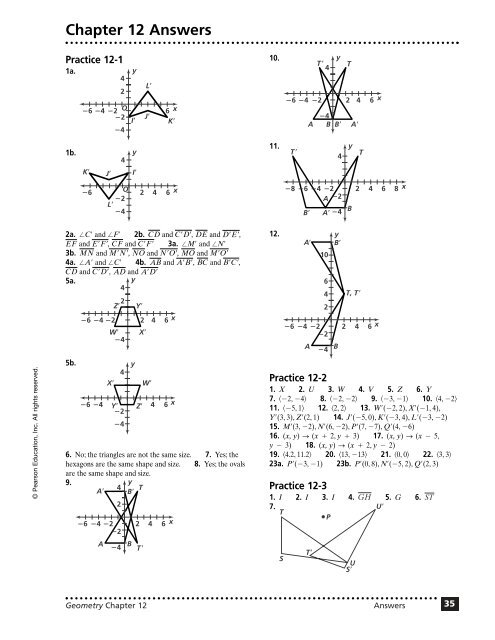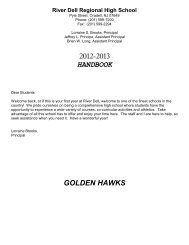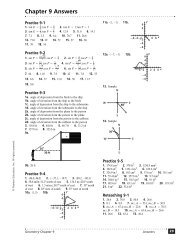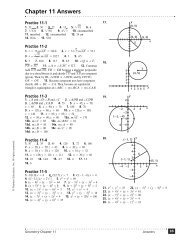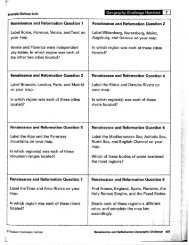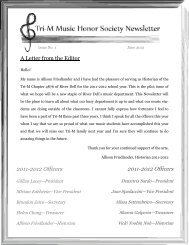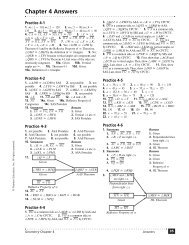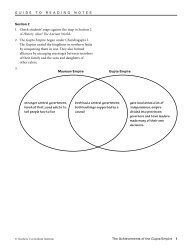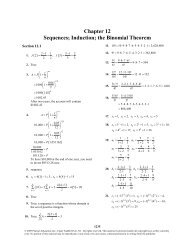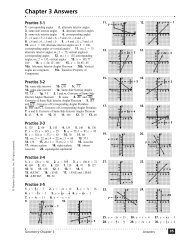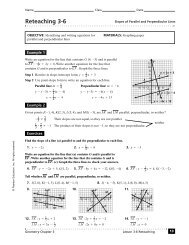Chapter 12 Answers (continued)
Chapter 12 Answers (continued)
Chapter 12 Answers (continued)
Create successful ePaper yourself
Turn your PDF publications into a flip-book with our unique Google optimized e-Paper software.
<strong>Chapter</strong> <strong>12</strong> <strong>Answers</strong><br />
Practice <strong>12</strong>-1<br />
1a.<br />
y<br />
4<br />
L<br />
2<br />
6 4 2 O<br />
6 x<br />
2 J<br />
I K<br />
4<br />
10.<br />
T<br />
4<br />
6 4 2 2 4 6<br />
A<br />
y<br />
4<br />
B B<br />
T<br />
A<br />
x<br />
1b.<br />
4<br />
y<br />
11.<br />
T<br />
4<br />
y<br />
T<br />
K<br />
J<br />
I<br />
6<br />
O<br />
2 4 6<br />
2<br />
L<br />
4<br />
x<br />
8 6 4 2 2 4 6 8<br />
A 2<br />
B A 4<br />
B<br />
x<br />
© Pearson Education, Inc. All rights reserved.<br />
2a. C and F 2b. CD and CD, DE and DE,<br />
EF and EF, CF and CF 3a. M and N<br />
3b. MN and MN, NO and NO, MO and MO<br />
4a. A and C 4b. AB and AB, BC and BC,<br />
CD and CD, AD and AD<br />
5a.<br />
y<br />
4<br />
5b.<br />
6. No; the triangles are not the same size. 7. Yes; the<br />
hexagons are the same shape and size. 8. Yes; the ovals<br />
are the same shape and size.<br />
9.<br />
y<br />
A<br />
4 T<br />
B<br />
2<br />
6 4 2 2 4 6 x<br />
2<br />
A<br />
X<br />
2<br />
Z<br />
6 4 2 2 4 6<br />
W<br />
4<br />
4<br />
4<br />
6 4 Y 4 6 x<br />
Z<br />
2<br />
4<br />
B<br />
y<br />
Y<br />
X<br />
T<br />
W<br />
x<br />
<strong>12</strong>.<br />
Practice <strong>12</strong>-2<br />
1. X 2. U 3. W 4. V 5. Z 6. Y<br />
7. -2, -4 8. -2, -2 9. -3, -1 10. 4, -2<br />
11. -5, 1 <strong>12</strong>. 2, 2 13. W(-2, 2), X(-1, 4),<br />
Y(3, 3), Z(2, 1) 14. J(-5, 0), K(-3, 4), L(-3, -2)<br />
15. M(3, -2), N(6, -2), P(7, -7), Q(4, -6)<br />
16. (x, y) S (x + 2, y + 3) 17. (x, y) S (x - 5,<br />
y - 3) 18. (x, y) S (x + 2, y - 2)<br />
19. 4.2, 11.2 20. 13, -13 21. 0, 0 22. 3, 3<br />
23a. P(-3, -1) 23b. P(0, 8), N(-5, 2), Q(2, 3)<br />
Practice <strong>12</strong>-3<br />
1. I 2. I 3. I 4. GH 5. G 6. ST<br />
7.<br />
U<br />
T<br />
P<br />
S<br />
A<br />
T<br />
10<br />
6<br />
4<br />
2<br />
6 4 2 2 4 6 x<br />
2<br />
A<br />
4<br />
y<br />
B<br />
B<br />
T, T<br />
U<br />
S<br />
Geometry <strong>Chapter</strong> <strong>12</strong> <strong>Answers</strong> 35
C<br />
<strong>Chapter</strong> <strong>12</strong> <strong>Answers</strong> (<strong>continued</strong>)<br />
8.<br />
9.<br />
P<br />
O<br />
Practice <strong>12</strong>-4<br />
1. I. D II. C III. B IV. A 2. I. B II. A III. C IV. D<br />
3.<br />
B<br />
B<br />
B<br />
m<br />
N<br />
P<br />
P<br />
<br />
m<br />
Q<br />
O<br />
Q<br />
4.<br />
C<br />
N<br />
C<br />
10.<br />
O<br />
P<br />
N<br />
O<br />
m<br />
11. L<br />
<strong>12</strong>.<br />
13.<br />
O<br />
P'<br />
S<br />
S<br />
P'<br />
R<br />
N<br />
P M<br />
Q<br />
N<br />
R<br />
P<br />
P<br />
M<br />
O<br />
Q'<br />
P<br />
Q<br />
Q<br />
Q<br />
Q'<br />
R'<br />
R'<br />
Q<br />
L<br />
L<br />
L<br />
N<br />
M<br />
L<br />
L<br />
E<br />
M<br />
Q<br />
M<br />
Q<br />
P<br />
N<br />
P<br />
O<br />
5.<br />
6.<br />
7.<br />
8.<br />
S<br />
T<br />
B<br />
<br />
J<br />
4<br />
4<br />
2<br />
J<br />
y<br />
10<br />
y<br />
<br />
8<br />
6<br />
4<br />
E<br />
2<br />
S<br />
y<br />
E<br />
m<br />
J<br />
2 O 2 4 6 x<br />
2<br />
T<br />
E<br />
B<br />
S<br />
4 2 O 2 4 x<br />
m<br />
© Pearson Education, Inc. All rights reserved.<br />
2 O 2 4 6 8 x<br />
2<br />
T<br />
B<br />
4<br />
36<br />
<strong>Answers</strong> Geometry <strong>Chapter</strong> <strong>12</strong>
<strong>Chapter</strong> <strong>12</strong> <strong>Answers</strong> (<strong>continued</strong>)<br />
9.<br />
T<br />
y<br />
S<br />
5.<br />
4<br />
2<br />
E<br />
2 O 2 4 6<br />
B 2<br />
x<br />
6.<br />
10.<br />
y<br />
6<br />
B<br />
4<br />
4<br />
2<br />
2 O 2<br />
T <br />
4<br />
2<br />
E<br />
4<br />
S<br />
x<br />
7. This figure has no lines of symmetry.<br />
8.<br />
line symmetry and 72° rotational<br />
symmetry<br />
11.<br />
2<br />
y<br />
B<br />
9.<br />
6 E 2 O 4<br />
2<br />
4<br />
S<br />
T<br />
x<br />
10.<br />
line symmetry<br />
<strong>12</strong>.<br />
S<br />
4<br />
2<br />
y<br />
E<br />
line symmetry and 90° rotational<br />
symmetry<br />
© Pearson Education, Inc. All rights reserved.<br />
13.<br />
T<br />
B<br />
2 O 2 4 6 x<br />
2<br />
4<br />
4<br />
2<br />
4 2 O 2 4 6 x<br />
2<br />
4<br />
y<br />
E<br />
14. reflection 15. rotation 16. glide reflection<br />
17. translation<br />
B<br />
T <br />
S<br />
11.<br />
<strong>12</strong>.<br />
13.<br />
14.<br />
X<br />
O<br />
X<br />
line symmetry and 45° rotational<br />
symmetry<br />
180° rotational symmetry<br />
line symmetry<br />
Practice <strong>12</strong>-5<br />
1. The helmet has reflectional symmetry. 2. The teapot<br />
has reflectional symmetry. 3. The hat has both rotational<br />
and reflectional symmetry. 4. The hairbrush has<br />
reflectional symmetry.<br />
15.<br />
line symmetry and 45° rotational<br />
symmetry<br />
180° rotational symmetry<br />
Geometry <strong>Chapter</strong> <strong>12</strong> <strong>Answers</strong> 37
<strong>Chapter</strong> <strong>12</strong> <strong>Answers</strong> (<strong>continued</strong>)<br />
16.<br />
5.<br />
17. 18.<br />
line symmetry<br />
COOK<br />
6.<br />
line symmetry,<br />
rotational symmetry,<br />
translational symmetry,<br />
glide reflectional symmetry<br />
19. 20.<br />
21.<br />
H<br />
O<br />
A<br />
X<br />
7. 8.<br />
9.–11. Samples:<br />
9. 10.<br />
rotational symmetry,<br />
translational symmetry<br />
Practice <strong>12</strong>-6<br />
1.<br />
11.<br />
2.<br />
3.<br />
4.<br />
translational symmetry<br />
line symmetry,<br />
rotational symmetry,<br />
translational symmetry,<br />
glide reflectional symmetry<br />
translational symmetry<br />
<strong>12</strong>. yes 13. yes 14. no 15. yes 16. no<br />
17. no<br />
Practice <strong>12</strong>-7<br />
1. L(-2, -2), M(-1, 0), N(2, -1), O(0, -1)<br />
2. L(-30, -30), M(-15, 0), N(30, -15), O(0, -15)<br />
3. L(-<strong>12</strong>, -<strong>12</strong>), M(-6, 0), N(<strong>12</strong>, -6), O(0, -6)<br />
5 1<br />
4. 3<br />
5.<br />
2<br />
6. 2 7. yes 8. no 9. no<br />
10. R<br />
R<br />
11.<br />
A<br />
A<br />
O<br />
T<br />
T<br />
R<br />
R<br />
© Pearson Education, Inc. All rights reserved.<br />
line symmetry,<br />
rotational symmetry,<br />
translational symmetry,<br />
glide reflectional symmetry<br />
A<br />
A<br />
T<br />
38<br />
<strong>Answers</strong> Geometry <strong>Chapter</strong> <strong>12</strong>
<strong>Chapter</strong> <strong>12</strong> <strong>Answers</strong> (<strong>continued</strong>)<br />
<strong>12</strong>.<br />
R<br />
8.<br />
Z<br />
R<br />
Y<br />
O<br />
X<br />
A<br />
T<br />
X<br />
Z<br />
A<br />
T<br />
1 1<br />
13. P(-<strong>12</strong>, -<strong>12</strong>), Q(-6, 0), R(0, -6) 14. P(- 2, 4 ),<br />
1 1 3<br />
Q(1 4<br />
,-<br />
4), R(1 4,2) 15. P(-21, 6), Q(3, 24),<br />
R(-6, 6) 16. P(-2, 1), Q(-1, 0), R(0, 1)<br />
Reteaching <strong>12</strong>-1<br />
1.–5. Check students’ work. 6. reflection over x-axis:<br />
F(-1, -3), G(-5, -1), H(-3, -5); reflection over y-axis:<br />
F(1, 3), G(5, 1), H(3, 5) 7. reflection over x-axis:<br />
C(2, -4), D(5, -2), E(6, -3); reflection over y-axis:<br />
C(-2, 4), D(-5, 2), E(-6, 3) 8. reflection over x-axis:<br />
J(-1, 5), K(-2, 3), L(-4, 6); reflection over y-axis:<br />
J(1, -5), K(2, -3), L(4, -6)<br />
Reteaching <strong>12</strong>-2<br />
1.–5. Check students’ work. 6. A(0, -3), B(1, 1),<br />
C(4, -1), D(5, -4) 7. A(4, -2), B(5, 2), C(8, 0),<br />
D(9, -3) 8. A(3, 5), B(4, 9), C(7, 7), D(8, 4)<br />
Reteaching <strong>12</strong>-4<br />
1. translation 2. reflection 3. rotation<br />
4. glide reflection 5. rotation 6. glide reflection<br />
7. reflection 8. translation<br />
Reteaching <strong>12</strong>-5<br />
1. two lines of symmetry (vertical and horizontal), 180°<br />
rotational symmetry (point symmetry) 2. one line of<br />
symmetry (horizontal) 3. one line of symmetry (vertical)<br />
4. two lines of symmetry (vertical and horizontal), 180°<br />
rotational symmetry (point symmetry) 5. one line of<br />
symmetry (vertical) 6. one line of symmetry (vertical)<br />
Reteaching <strong>12</strong>-6<br />
1.<br />
© Pearson Education, Inc. All rights reserved.<br />
Reteaching <strong>12</strong>-3<br />
1.–5.<br />
6.<br />
Y<br />
Y<br />
7. Sample:<br />
Y<br />
Z<br />
Z<br />
X<br />
X<br />
Z<br />
X<br />
T<br />
X<br />
T<br />
Y<br />
Y<br />
Z<br />
Z<br />
2. Sample:<br />
3.<br />
4.<br />
line symmetry in the dashed lines,<br />
rotational symmetry around points,<br />
translational symmetry,<br />
glide reflectional symmetry<br />
line symmetry in the dashed lines,<br />
rotational symmetry around points,<br />
translational symmetry,<br />
glide reflectional symmetry<br />
Y<br />
X<br />
S<br />
Z<br />
X<br />
rotational symmetry around<br />
points, translational symmetry<br />
Geometry <strong>Chapter</strong> <strong>12</strong> <strong>Answers</strong> 39
<strong>Chapter</strong> <strong>12</strong> <strong>Answers</strong> (<strong>continued</strong>)<br />
5.<br />
Reteaching <strong>12</strong>-7<br />
1. Check students’ work.<br />
2.<br />
4<br />
y<br />
2<br />
4 2 O<br />
2<br />
2 4<br />
x<br />
line symmetry in the dashed<br />
lines, rotational symmetry<br />
around points, translational<br />
symmetry, glide reflectional<br />
symmetry<br />
5.<br />
1<br />
2<br />
6. y =<br />
1<br />
x + 2<br />
6<br />
K<br />
4<br />
2<br />
J<br />
6 4 2 0<br />
2<br />
J'<br />
4<br />
6<br />
7.<br />
4<br />
y<br />
L<br />
L'<br />
2 4 6 x<br />
K'<br />
y<br />
4<br />
T'<br />
2<br />
3.<br />
4.<br />
4<br />
2<br />
y<br />
4 O 2 4<br />
2<br />
4<br />
x<br />
4<br />
y<br />
6 4 2 0<br />
Q'<br />
2<br />
Q<br />
T<br />
y =-4<br />
8.<br />
4<br />
6<br />
8<br />
6<br />
y<br />
R'<br />
R<br />
2 S' 4 6x<br />
S<br />
E'<br />
5.<br />
<strong>12</strong><br />
10<br />
6<br />
4<br />
2<br />
86<br />
2 2 4 6 8 x<br />
4<br />
6<br />
8<br />
10<br />
<strong>12</strong><br />
y<br />
2<br />
<strong>12</strong> 8 6 4 2 O 2 4 6 8 <strong>12</strong>x<br />
2<br />
4<br />
y =-x<br />
9.<br />
D<br />
6<br />
4<br />
2<br />
6 4 0<br />
B<br />
2<br />
C<br />
D<br />
D'<br />
A<br />
4<br />
2<br />
6 4 2 0<br />
2<br />
F<br />
E<br />
4<br />
6<br />
4<br />
y<br />
F'<br />
2 4 6x<br />
A'<br />
2 6<br />
B'<br />
C'<br />
D'<br />
x<br />
© Pearson Education, Inc. All rights reserved.<br />
Enrichment <strong>12</strong>-1<br />
1. (-3, -1) 2. (-1, 0) 3. (5, 3)<br />
x 1<br />
1 x 2<br />
y 1<br />
1 y 2<br />
4. the midpoint formula: M = ( , )<br />
2<br />
2<br />
6<br />
x = 1<br />
40 <strong>Answers</strong> Geometry <strong>Chapter</strong> <strong>12</strong>
<strong>Chapter</strong> <strong>12</strong> <strong>Answers</strong> (<strong>continued</strong>)<br />
10.<br />
M'<br />
6<br />
M<br />
y<br />
N<br />
Enrichment <strong>12</strong>-4<br />
1.–9. Check students’ work. 10. <strong>12</strong>-3; rotation; twice<br />
11. 130 <strong>12</strong>. 100 13. 160<br />
2<br />
8 6 4 2 0<br />
N'<br />
2<br />
Q'<br />
4<br />
P'<br />
6<br />
y =-2x - 2<br />
11.<br />
U'<br />
6<br />
V'<br />
4<br />
2<br />
W' T'<br />
8 6 4 2 0<br />
2<br />
4<br />
6<br />
Q<br />
y<br />
T<br />
P<br />
4 6x<br />
U<br />
V<br />
4 6x<br />
W<br />
Enrichment <strong>12</strong>-5<br />
1. yes; rotational and point symmetry 2. no 3. yes;<br />
rotational and point symmetry 4. yes; rotational and point<br />
symmetry 5. no 6. no 7. diamonds 8. <strong>12</strong><br />
9. Seven of diamonds; this does not have symmetry because<br />
the diamond in the middle is toward either the bottom or top<br />
of the card, and when you rotate the card 180°, the position<br />
will be reversed. 10. All the face cards have symmetry.<br />
11. yes; 2, 4, 10 <strong>12</strong>. No; Sample: When you look at the<br />
card one way, three of the points of the hearts are pointing<br />
down, and five are pointing up. When you rotate the card 180º,<br />
five of the points of the hearts are pointing down, and three<br />
are pointing up. 13. No; because the number and suit of<br />
each card are placed in opposite corners, none of the cards<br />
have line symmetry. 14. You can add a backward 3 with<br />
the small club below it to the two empty corners to create line<br />
symmetry, or you can remove the 3 with the small club below<br />
it from each of the two corners.<br />
Enrichment <strong>12</strong>-6<br />
y = 3x + 2<br />
<strong>12</strong>.<br />
G'<br />
6<br />
4<br />
y<br />
© Pearson Education, Inc. All rights reserved.<br />
1<br />
y =-x 2 - 1<br />
H'<br />
2<br />
8 6 4 2 0<br />
H<br />
2<br />
G<br />
4<br />
I<br />
6<br />
K'<br />
2 J' 4 6x<br />
Enrichment <strong>12</strong>-2<br />
1. -7, -2 2. 4, -7 3. -10, 5 4. -3, -9<br />
5. Foster 6. yes 7. Wilson 8. -7, -3 9. C<br />
I'<br />
J<br />
K<br />
Enrichment <strong>12</strong>-3<br />
1. (0, -2, 3) 2. (-2, -2, 3) 3. (-2, -2, 0)<br />
4. (0, -2, 0) 5. (0, -6, 0) 6. (0, -6, 3)<br />
7. (-2, -6, 3) 8. (-2, -6, 0) 9. (2, 0, 3)<br />
10. (2, -2, 3) 11. (2, -2, 0) <strong>12</strong>. (2, 0, 0)<br />
13. (6, 0, 0) 14. (6, 0, 3) 15. (6, -2, 3)<br />
16. (6, -2, 0)<br />
Enrichment <strong>12</strong>-7<br />
1a. (2, 0, 2) 1b. (0, 0, 2) 1c. (0, 2, 2) 1d. (2, 2, 2)<br />
1e. (2, 0, 0) 1f. (0, 0, 0) 1g. (0, 2, 0) 1h. (2, 2, 0)<br />
2a. (4, 0, 4) 2b. (0, 0, 4) 2c. (0, 4, 4) 2d. (4, 4, 4)<br />
2e. (4, 0, 0) 2f. (0, 0, 0) 2g. (0, 4, 0) 2h. (4, 4, 0)<br />
3. (0, 0, 0) 4. 2 5. Each edge in the image is double<br />
that in the preimage. 6. Samples: Three faces are<br />
coplanar for image and preimage; three faces are parallel;<br />
Geometry <strong>Chapter</strong> <strong>12</strong> <strong>Answers</strong> 41
<strong>Chapter</strong> <strong>12</strong> <strong>Answers</strong> (<strong>continued</strong>)<br />
each face in the image has two times the perimeter and four<br />
times the area of the corresponding face in the preimage.<br />
7. Surface area of image = 96 sq. units; surface area of<br />
preimage = 24 sq. units; the ratio of the surface areas is<br />
4 : 1. 8. Volume of image = 64 cubic units; volume of<br />
preimage = 8 cubic units; the ratio of the volumes is 8 : 1.<br />
9. Dilations in three dimensions are proportional to dilations<br />
in two dimensions.<br />
<strong>Chapter</strong> Project<br />
Activity 1: Investigating<br />
a. vertical<br />
b. vertical<br />
c. both<br />
Activity 2: Modeling<br />
a. Ancient Egyptian ornament<br />
✔ Checkpoint Quiz 2<br />
1. line symmetry;<br />
rotational; 180°<br />
2. line symmetry;<br />
rotational; 180°<br />
3. line symmetry<br />
H<br />
b. Oriental design<br />
c. Greek vase design<br />
Activity 3: Investigating<br />
a, b<br />
Activity 4: Classifying<br />
a. mg<br />
b. <strong>12</strong><br />
Activity 5: Creating<br />
Check students’ work.<br />
✔ Checkpoint Quiz 1<br />
1. No; the figures are not the same size. 2. yes<br />
3. yes 4. –3, –2 5. 6 units right and 4 units down<br />
6. a resultant translation of 4 units right and 11 units up<br />
7. C<br />
8. D'<br />
L<br />
C'<br />
B'<br />
L' A B'<br />
B D<br />
B<br />
C<br />
C'<br />
A, A'<br />
9.<br />
C<br />
C'<br />
A<br />
D D'<br />
10. T( 8, -5), Q(2, -3) and R(4, 0)<br />
4. rotational; 180° 5. translational; no turns<br />
6. rotational; preimage turns 7. translational<br />
8. rotational, reflectional, translational 9. translational<br />
<strong>Chapter</strong> Test, Form A<br />
1. P(13, 0), Q(10, -2), R(11, -4), S(13, -6)<br />
2. P(-1, -2), Q(2, -4), R(1, -6), S(-1, -8)<br />
3. P(0, -5), Q(2, -2), R(4, -3), S(6, -5)<br />
4. P(-2.5, 0), Q(-1, -1), R(-1.5, -2), S(-2.5, -3)<br />
5. P(5, 2), Q(2, 0), R(3, -2), S(5, -4) 6. P(-11, 3),<br />
Q(-8, 1), R(-9, -1), S(-11, -3) 7. glide reflection<br />
8. translation 9. translation 10. rotation<br />
11.<br />
<strong>12</strong>. line symmetry 13. rotational symmetry<br />
14a. Any two of the following: ABCDEHIKMOTUVWXY<br />
14b. Any two of the following: HINOSXZ<br />
15. Translations can be performed on the pieces because they<br />
can slide. Rotations can be performed on the pieces because<br />
each piece can be turned. Reflections and glide reflections<br />
cannot be performed on the pieces because the back of a<br />
puzzle piece is useless in solving the puzzle. Dilations are<br />
impossible because the pieces cannot change size.<br />
16. A 17. Sample: glide reflectional, rotational, line,<br />
and translational<br />
1 3<br />
18. L(-3, 6), M(6, 6), N(3, -9) 19. L( 2 , - 4 ),<br />
3 5 1<br />
M( 4 ,1), N( 4, - 2) 20. L(-18, -18), M(-18, 18),<br />
5 7<br />
N(0, 0) 21. L(3, -2), M(0, - 3 ), N( 3, -2)<br />
© Pearson Education, Inc. All rights reserved.<br />
42<br />
<strong>Answers</strong> Geometry <strong>Chapter</strong> <strong>12</strong>
<strong>Chapter</strong> <strong>12</strong> <strong>Answers</strong> (<strong>continued</strong>)<br />
3<br />
22. YZ = 15 cm; XZ = 24 cm; scale factor = 7<br />
5<br />
23. XY = 25 in.; YZ = 40 in.; scale factor = 3<br />
24. (-1, 3) 25. (5, 4) 26. (-2, -7) 27. (2, -7)<br />
28. (1, -1) 29. (-3, 1)<br />
<strong>Chapter</strong> Test, Form B<br />
1. W(-6, -1), X(-4, -4), Y(0, -3), Z(-2, 0)<br />
2. W(-5, 0), X(-3, 3), Y(1, 2), Z(-1, -1)<br />
3. W(3, 6), X(6, 4), Y(5, 0), Z(2, 2) 4. W(-2, 1),<br />
4 5 2 2<br />
X(- 3,2), Y(0, 3), Z(- 3, 3) 5. W(-3, -3),<br />
X(-1, -6), Y(3, -5), Z(1, -2) 6. W(-9, 1),<br />
X(-7, 4), Y(-3, 3), Z(-5, 0) 7. glide reflection<br />
8. translation 9. translation 10. rotation<br />
11.<br />
<strong>12</strong>. no symmetry 13. line symmetry 14a. Any two<br />
of the following: ABCDEHIKMOTUVWXY 14b. Any<br />
two of the following: HINOSXZ 15. Reflections and glide<br />
reflections cannot be performed on the pieces because the<br />
back of a puzzle piece is useless in solving the puzzle. Dilations<br />
are impossible because the pieces cannot change size. Translations<br />
can be performed on the pieces because they can slide.<br />
Rotations can be performed on the pieces because each piece<br />
can be turned. 16. B 17. Sample: glide reflectional,<br />
rotational, line, and translational<br />
TASK 2: Scoring Guide<br />
Sample:<br />
3 Student draws a figure that accurately reflects the stated<br />
conditions.<br />
2 Student draws a figure that is mostly correct but falls just<br />
short of satisfying all the stated conditions.<br />
1 Student draws a figure that has significant flaws relative to<br />
the stated conditions.<br />
0 Student makes little or no effort.<br />
TASK 3: Scoring Guide<br />
Sample:<br />
The car can undergo translations and rotations as it moves<br />
and turns. But it can undergo neither a dilation, which would<br />
change its size, nor a reflection, which would, for example,<br />
put the steering wheel on the passenger side.<br />
3 Student gives a correct and thorough explanation.<br />
2 Student gives an explanation that demonstrates<br />
understanding of transformations but may contain minor<br />
errors or omissions.<br />
1 Student gives an explanation containing major errors or<br />
omissions.<br />
0 Student makes little or no effort.<br />
TASK 4: Scoring Guide<br />
Sample:<br />
4<br />
y<br />
© Pearson Education, Inc. All rights reserved.<br />
1 5 1<br />
18. S(- 4,1), T(1, 4 ), U(0, 2) 19. S(0, 0),<br />
T(20, -8), U(<strong>12</strong>, -20) 20. S(-20, -15), T(-20, 5),<br />
5 1<br />
U(-10, -10) 21. S(- 2,4), T(- 2, -1), U(-3, -4)<br />
3<br />
22. YZ = 63 cm; XZ = 39 cm; scale factor = 2<br />
3<br />
23. XY = 21 ft; XZ = <strong>12</strong> ft; scale factor = 4<br />
24. (-5, 2) 25. (7, 3) 26. (-1, -2) 27. (4, -1)<br />
28. (3, -8) 29. (-4, 0)<br />
Alternative Assessment, Form C<br />
TASK 1: Scoring Guide<br />
20; 200 cm; all distances are magnified 20 times.<br />
3 Student gives correct answers and a clear and accurate<br />
explanation.<br />
2 Student gives answers and an explanation that are largely<br />
correct.<br />
1 Student gives answers or an explanation that may contain<br />
serious errors.<br />
0 Student makes little or no effort.<br />
4<br />
a. translation:<br />
4<br />
2<br />
4<br />
2<br />
4<br />
2<br />
4<br />
b. dilation:<br />
4<br />
2<br />
y<br />
y<br />
2 2<br />
2<br />
4 x<br />
2 4x<br />
x<br />
translation vector: 1, 0<br />
scale factor: 2<br />
Geometry <strong>Chapter</strong> <strong>12</strong> <strong>Answers</strong> 43
<strong>Chapter</strong> <strong>12</strong> <strong>Answers</strong> (<strong>continued</strong>)<br />
c. reflection:<br />
y<br />
2<br />
4 2<br />
2<br />
4<br />
d. glide reflection:<br />
e. rotation:<br />
4 2<br />
4<br />
2<br />
4 2<br />
2<br />
4<br />
4<br />
2<br />
y<br />
y<br />
2<br />
4 x<br />
4 x<br />
4 x<br />
line of reflection: y = 1<br />
The glide reflection is equivalent to<br />
a translation 2, 0 followed by a<br />
reflection in the line y =-2.<br />
degrees of rotation: 90<br />
19.<br />
20. Equilateral triangle, square, and regular hexagon;<br />
the measure of each interior angle is a factor of 360.<br />
21. If a triangle is not a right triangle, then the Pythagorean<br />
Theorem cannot be applied.<br />
22.<br />
y<br />
4<br />
V<br />
2<br />
V<br />
U U<br />
4 2 4 6 x<br />
W<br />
2<br />
W<br />
4<br />
23. 21.21<br />
T<br />
4<br />
2<br />
T<br />
4 2 4 x<br />
U G<br />
2<br />
y<br />
U<br />
G<br />
4<br />
3 Student gives accurate graphs and correctly identifies the<br />
details the problem calls for.<br />
2 Student gives generally correct graphs and details, although<br />
the work may contain some errors.<br />
1 Student gives graphs and accompanying details that contain<br />
significant errors or omissions.<br />
0 Student makes little or no effort.<br />
Cumulative Review<br />
1. D 2. B 3. B 4. C 5. A 6. D 7. B<br />
8. C 9. C 10. D 11. B <strong>12</strong>. C 13. A<br />
14. D 15. B 16. 49 cm 3 17. A, H, I, M, O, T, U, V,<br />
W, X, Y 18. Rotational; it is turning around a fixed point,<br />
the corner.<br />
© Pearson Education, Inc. All rights reserved.<br />
44<br />
<strong>Answers</strong> Geometry <strong>Chapter</strong> <strong>12</strong>


